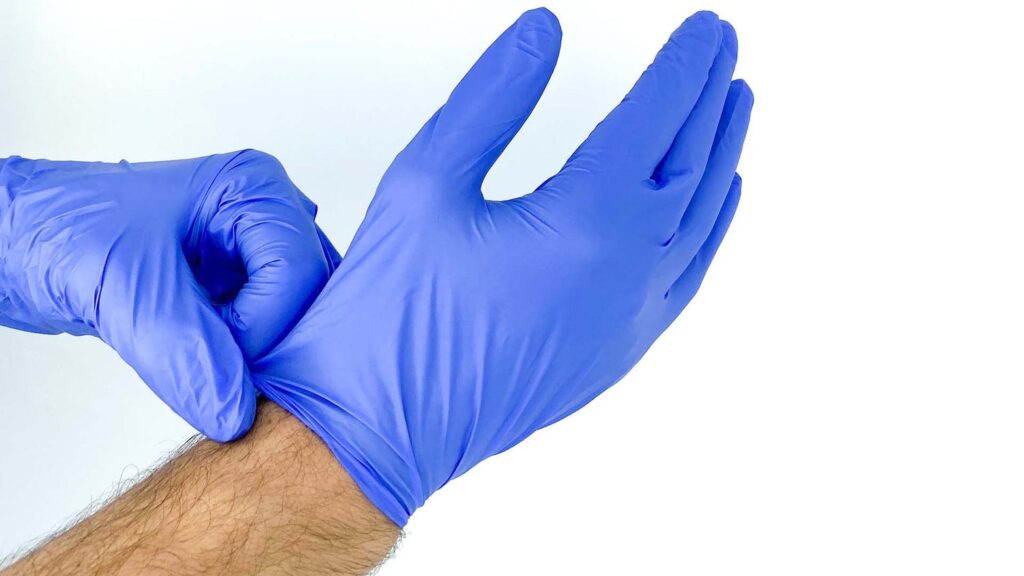Gloves are critical personal protective equipment (PPE), and they are used across a wide range of industries, from healthcare to food service, manufacturing, automotive, and many others.
Gloves serve as a critical barrier against contamination, chemical exposure, and exposure to pathogens. With a variety of materials available, it’s important to understand the differences between glove types so that you can select the best type for a specific task.
The most common types of gloves used by the workforce are nitrile, latex, and vinyl, however, there are also other materials like polyethylene and specialty gloves designed for specific applications.
Nitrile Gloves
Nitrile gloves are made from synthetic rubber and are a popular alternative to latex gloves, especially for individuals with latex allergies or sensitivity. They are appreciated for their excellent resistance to punctures, tears, chemicals, and abrasions. For this reason, nitrile gloves are widely used in medical environments, research and other scientific laboratories, and in industries where contact with harsh chemicals is likely.
One of the main advantages of nitrile as a glove material is its durability. Gloves made from this material are stronger than latex or vinyl and provide superior protection against solvents, oils, and some acids. Nitrile gloves also provide a high level of tactile sensitivity (slightly less than that of latex). They are manufactured in various thicknesses and colours, with blue or purple being commonly used in healthcare (purple specifically for chemotherapy) to easily distinguish them from other glove types.
Latex Gloves
Latex gloves are made from natural rubber; they have been the standard disposable glove material for decades. They offer excellent comfort, fit, and elasticity, and a high level of dexterity and tactile sensitivity. They can be ideal for medical and dental procedures where precision is critical.
Latex gloves do have a significant drawback: some people may develop skin irritation or a more severe allergic reaction upon exposure to latex. Consequently, many institutions have moved away from using latex in favour of synthetic alternatives like nitrile.
Despite this, latex gloves still offer unmatched comfort and protection for tasks that require fine motor skills, and they remain the preferred choice in many surgical and laboratory settings.
Vinyl Gloves
Vinyl gloves are made from synthetic plastic polymers, typically polyvinyl chloride (PVC). These gloves are arguably the most economical option for disposable gloves and are often used for food service, cleaning, and light industrial tasks.
While vinyl gloves are latex-free and do offer basic barrier protection, they are not nearly as durable or flexible as nitrile or latex gloves. Vinyl gloves tend to have a looser fit and lower resistance to punctures and chemicals. As such, they are not recommended in medical or high-risk environments; for short-term, low-risk tasks, however, vinyl gloves are an adequate, cost-effective option.
Polyethylene Gloves
Polyethylene gloves are thin, loose-fitting gloves that are often used for food handling and other tasks that require frequent glove changes. They are most commonly found in delicatessans, cafeterias, and food prep areas.
Inexpensive, they provide a basic level of protection against contamination, but offer minimal durability and dexterity. They are not suitable for medical use of any kind or in any environment requiring strong chemical or puncture resistance.
Specialty and Reusable Gloves
Disposable types are most commonly used, but there are also numerous specialty gloves made for specific applications:
- Neoprene gloves are used in laboratories and for chemical handling due to their high resistance to acids and solvents.
- Butyl rubber gloves offer excellent protection against chemicals in hazardous material handling.
- Kevlar gloves provide sharps resistance and are used in industries like construction and manufacturing.
- Leather gloves are durable and used for heavy-duty tasks like welding or landscaping.
Choosing the Right Glove
When selecting gloves, you need to consider the specific requirements of the task at hand:
· level of protection
· fit and comfort
· tactile sensitivity
· potential for allergic reaction
In healthcare, nitrile gloves are often the safest all-around choice.
For food service, vinyl or polyethylene may be sufficient.
For industrial use, the selection will depend heavily on the types of hazards involved.
Understanding the properties of each glove material helps ensure safety, efficiency, and compliance in any environment where hand protection is essential.

